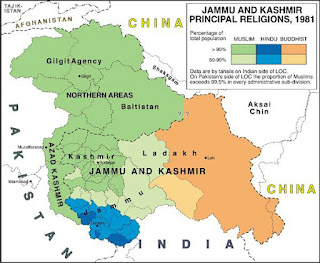JAMMU AND KASHMIR: DISTRIBUTION OF RELIGIONS
Three major faiths are each clearly dominant in different parts of the erstwhile princely state of Jammu and Kashmir.Islam is virtually the sole religion throughout the Northern Areas and Azad Kashmir on the Pakistani side of the 1972 Line of Control, accounting for more than 99.5% of the population in every single district of those two areas. On the Indian side of the LOC, Islam is clearly dominant in Kashmir, is also the leading faith in three of the six districts of Jammu, and accounts for a large majority of the population in the Kargil tahsil of Kargil district. Hinduism, the second most numerous faith, accounts for a majority ofthe population in the three southernmost districts of Jammuand in that region as a whole. Followers of the Tibetan form of Buddhism are a decided majority in the large, but thinly populated district of Leh and in Zanskar tahsil in the southern part of Kargil district. In Jammu and Kashmir as awhole, Islam is by far the leading faith and, with 74.9% of the total population, it accounted for a somewhat larger share of the total than it did at the time of partition, when, judging from the 1941 census, it accounted for 72.9% of the population.
While a clear majority of the Muslims in Jammu, in Kashmir proper, and in Azad Kashmir are followers of the Sunni form of the faith, large areas in Indian-held Ladakh, mostnotably in Kargil district, and in the Pakistani-held Northern Areas have majorities who follow various sects thatmay be grouped under the label Shiah. These include the Ismailis, whose spiritual leader is the Aga Khan, whose Aga Khan Rural Support Programme is a major source of development assistance to the region, on both sides of the LOC. Reliable statistics on sectarian distributions within Islam have never been collected. However, based on such pre-independence data as do exist, Shiahs (of various sub-sects) outnumber Sunnis in Indian-held Kargil, while, on the Pakistani side of the LOC, they lead in all parts of the Northern Areas except Gilgit tahsil of Gilgit district and the western tahsils of Diamir district. In those areas, owing in part to immigration from Punjab and the North-West Frontier Province since the completion of the Karakoram Highway, the two sects are believed to be in rough balance.



Comments
Post a Comment